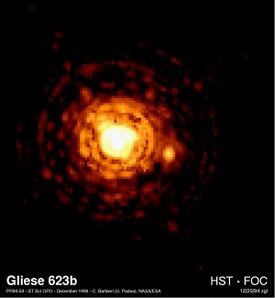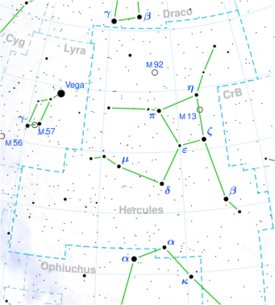Astronomy:Gliese 623
From HandWiki
Short description: Star system in the constellation Hercules
Coordinates: ![]() 16h 24m 09.32495s, +48° 21′ 10.4611″
16h 24m 09.32495s, +48° 21′ 10.4611″
| Observation data Equinox J2000.0]] (ICRS) | |
|---|---|
| Constellation | Hercules |
| Right ascension | 16h 24m 09.325s[1] |
| Declination | +48° 21′ 10.46″[1] |
| Characteristics | |
| Spectral type | M3.0V / M D ~ |
| Astrometry | |
| Proper motion (μ) | RA: 1146.26±1.21[1] mas/yr Dec.: −451.86±1.11[1] mas/yr |
| Parallax (π) | 127.4785 ± 0.4818[2] mas |
| Distance | 25.59 ± 0.10 ly (7.84 ± 0.03 pc) |
| Other designations | |
| Database references | |
| SIMBAD | data |
Location of Gliese 623 in the constellation Hercules | |
Gliese 623 is a dim double star 25.6 light years from Earth in the constellation Hercules. It was photographed by the NASA/ESA Hubble Space Telescope's Faint Object Camera in 1994. The binary system consists of two red dwarfs orbiting each other at a distance of 1.9 astronomical units.
See also
References
- ↑ 1.0 1.1 1.2 1.3 1.4 van Leeuwen, F. (2007). "Validation of the new Hipparcos reduction". Astronomy and Astrophysics 474 (2): 653–664. doi:10.1051/0004-6361:20078357. Bibcode: 2007A&A...474..653V. https://www.aanda.org/articles/aa/full/2007/41/aa8357-07/aa8357-07.html. Vizier catalog entry
- ↑ Brown, A. G. A. (August 2018). "Gaia Data Release 2: Summary of the contents and survey properties". Astronomy & Astrophysics 616: A1. doi:10.1051/0004-6361/201833051. Bibcode: 2018A&A...616A...1G. Gaia DR2 record for this source at VizieR.
Further reading
- Barbieri, C.; De Marchi, G.; Nota, A.; Corrain, G.; Hack, W.; Ragazzoni, R.; MacChetto, D. (November 1996). "First HST/FOC images of the low mass companion of the astrometric binary Gliese 623". Astronomy and Astrophysics 315 (1): 418–420. Bibcode: 1996A&A...315..418B.
- Martinache; Lloyd, James P.; Ireland, Michael J.; Yamada, Ryan S.; Tuthill, Peter G. (2007). "Precision Masses of the Low-Mass Binary System GJ 623". The Astrophysical Journal 661 (1): 496–501. doi:10.1086/513868. Bibcode: 2007ApJ...661..496M. http://www.iop.org/EJ/article/0004-637X/661/1/496/70964.html.
External links
 |



